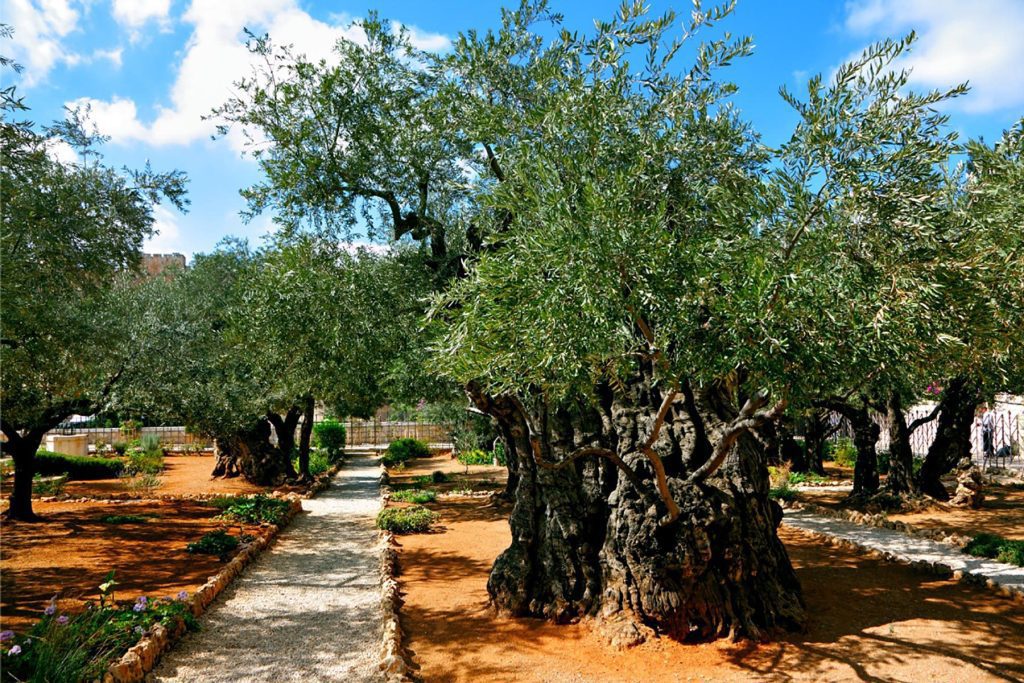Gethsemane is a garden at the foot of the Mount of Olives in Jerusalem. According to the four Gospels of the New Testament, Jesus underwent the Agony in the garden. Then he was arrested the night before his crucifixion. Also, it is a place of great resonance in Christianity. There are several small olive groves on the church property; all adjacent to each other and identified with biblical Gethsemane.
The name is derived from the Aramaic meaning “oil press”. Although Matthew 26:36 and Mark 14:32 call it a place or estate. The Gospel of John says Jesus entered a garden with his disciples. Hence today you have the conflation of the two, so it’s called ‘The Garden of Gethsemane’.

Plausible Locations of Gethsemane
According to the New Testament, it was a place that Jesus and his disciples customarily visited; which allowed Judas Iscariot to find him on the night of his arrest.
There are four locations, all of them at or near the western foot of the Mount of Olives, officially claimed by different denominations to be the place where Jesus prayed on the night he was betrayed.
- The garden at the Catholic Church of All Nations, built over the “Rock of the Agony”.
- The location near the Tomb of the Virgin Mary to the north.
- The Greek Orthodox location to the east.
- The Russian Orthodox orchard, next to the Church of Mary Magdalene.
The Words of Describing Gethsemane
William McClure Thomson, the author of The ‘Land and the Book’, first published in 1880, wrote:
“When I first came to Jerusalem, and for many years afterward, this plot of ground was open to all whenever they chose to come and meditate beneath its very old olive trees. The Latins, however, have within the last few years succeeded in gaining sole possession and have built a high wall around it. The Greeks have invented another site a little to the north of it. My own impression is that both are wrong. The position is too near the city, and so close to what must have always been the great thoroughfare eastward, that our Lord would scarcely have selected it for retirement on that dangerous and dismal night. I am inclined to place the garden in the secluded vale several hundred yards to the north-east of the present Gethsemane.”
All of the foregoing is based on long-held tradition and the conflating of the synoptic accounts of Mark (14:31) and Matthew (26:36) with the Johannine account (John 18:1). Mark and Matthew record that Jesus went to “a place called the oil press (Gethsemane)” and John states he went to a garden near the Kidron Valley. As a result, the modern scholarship acknowledges that the exact location of Gethsemane is unknown.
Gethsemane As A Pilgrimage Site
According to Luke 22:43–44, Jesus’ anguish on the Mount of Olives (Luke does not mention Gethsemane; Luke 22:39–40) was so deep that “his sweat was as it were great drops of blood falling down to the ground.”
The Garden of Gethsemane became a focal site for early Christian pilgrims. In fact, it was visited in 333 by the anonymous “Pilgrim of Bordeaux”; whose Itinerarium Burdigalense is the earliest description left by a Christian traveler in the Holy Land. In his Onomasticon, Eusebius of Caesarea notes the site of Gethsemane located “at the foot of the Mount of Olives”, and he adds that “the faithful were accustomed to go there to pray”.
Furthermore, eight ancient olive trees growing in the Latin site of the garden may even be 900 years old

